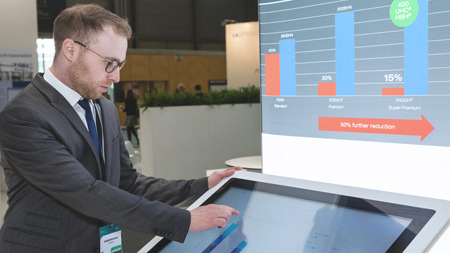Life-Cycle-Costing (LCC) is a cost management method, which looks at the development of a product in the railway system.
RAMS is an acronym for Reliability, Availability, Maintainability, and Safety, used to characterize the railway system.
Life-Cycle-Costing (LCC) is a cost management method, which looks at the development of a product in the railway system.
RAMS is an acronym for Reliability, Availability, Maintainability, and Safety, used to characterize the railway system.
The long-time engagement with the system railway and its interrelationships has taught us, that both, initial quality and adequate maintenance are key factors for a reliable and economic railway infrastructure. Thus, voestalpine has put a focus on improving the whole life cycle of our products.
Rail operators need an efficient and competitive infrastructure to compete with other modes of transport. Too often public procurement follows the principle of the cheapest provider. However, ecological criteria and factors such as availability, performance and costs can already be assessed today over the entire lifecycle.

As the leader in railway infrastructure technology, we continuously strive to improve our products for all kinds of railway applications to reach the longest possible service lives and lowest maintenance needs, even under the most challenging conditions.
The terms RAMS (Reliability, Availability, Maintenance and Safety), LCC (Life Cycle Costs) and CSR (Corporate Social Responsibility) have thus been key terms that accompanied product development from the early days but gained more and more importance over recent years.
While LCC analyses evaluate all costs that arise during a product’s life cycle, and thus reflect one of the most relevant criteria when purchasing new products, RAMS reflects the technical basis for these analyses. In other words, RAMS figures reflect the technical key performance indicators of railway components and only profound in-track evaluation with qualified personal and sophisticated measuring equipment can form the basis for these evaluations.
Furthermore, taking its social and environmental responsibility very seriously, voestalpine is expanding the scope of assessment from the railway system to overall sustainable correlations. Life cycle assessment (LCA) is therefore used as a multi-step procedure for calculating the lifetime environmental impact of our products.
The overall global warming potential used as a significant parameter for the environmental impact– often referred to as “Carbon footprint” – of a railway infrastructure solution is ideally used to evaluate the environmental impact of products. Thereby not only the production processes and technologies, such as the environmentally friendly HSH® technology of voestalpine shall be taken into consideration. A representative economic and ecological product evaluation can only be made by focusing a life cycle approach, considering all stages of a products life in a holistic way ("from cradle to grave" principle).
Whether it is Super Premium rail steels, high-speed turnouts with moveable point frogs or innovative and intelligent signaling solutions, when it comes to product design, our focus has always been on providing the highest quality and ensuring maximum customer benefit in terms of technical, economic and environmental considerations.
With the aim to find a customized investment strategy (bringing the right products in the right place), voestalpine has developed a landscape of three different LCC tools enabling the customer to compare the economic and environmental impacts of products and various system solutions.
The tools aim to provide fully transparent LCC analyses for rails and turnouts for our customers - proving the trust that our long-lasting, low-maintenance components will lead to the lowest overall costs of ownership with optimized maintenance and best ecological figures.
The “LCC Rail – Segment” tool was especially developed to analyze the LCC for a single curve under given circumstances. The tool enables us to provide LCC-evaluations for critical points in new projects or give very precise analyses for track approvals. Besides the LCC aspect, the CSR parameter "Carbon Footprint" based on production exhausts can be calculated, as longer rail service lives ultimately lead to lower overall production and consequently a reduction of CO2 emissions.
The "LCC Turnout" tool follows the analytical logic of the "LCC rail" tool and is able to evaluate the economic impact when choosing different turnout components, leading to a tailor-made recommendation with the components fitting best to the customer’s system.
The "LCC Rail – Line" application is the innovation of our tool landscape. It is a GIS (Geo Information System) application based on decade-long field measurements of different rail steels under heavy haul, mixed traffic, metro and tramway operation. It is a strategic tool, where different rail grade and maintenance strategies can be compared for whole track sections based on RAMS, LCC and CSR parameters. The effective combination of the tools aims to offer a solid decision-making basis for railway engineers independently if they are maintaining existing systems or considering investments in new systems.
While the long year measuring experience of voestalpine, on a global scale, form the basis for the evaluations, the LCC analyses can be further fine-tuned by using in track measurement data from customers’ databases. Experience in various joint investigations has shown that the use of these data sources ultimately leads to the most precise results and the most solid decision-making basis. However, this new landscape tool not only addresses our customers, it also assists consultants when considering the right choice of product, and can help universities or research institutions when evaluating future generation products.
By combining the expertise of our engineers with our new tools, voestalpine Railway Systems assists customers on their way of finding the most economic and ecologic product investment strategy.
If you have questions or feedback, please feel free to contact us. We are happy to help!